News
Inept engineers, local councils and builders laying base for disasters
This week in Ahangama a recreational hall and a hotel building under construction collapsed under its own weight injuring six workers. In four months, three buildings have crumbled.
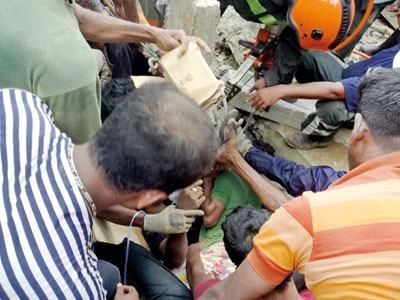
One vicitm being pulled out and another being attended to (below). Pix by Sirangika Lokukarawita
Sri Lanka’s construction industry is notorious also for building site deaths of workers and accidents.
Local authorities have been accused of not monitoring and not having mechanisms to check construction projects. Local councils do not have professionals, either.
The professional construction industry bodies themselves have not been proactive.
In August, at Periyamulla, Negombo, a building designed for a hotel and a shopping centre collapsed injuring four workers. Before that, in May, a section of a five-storey banquet hall at Wellawatte collapsed killing one and injuring over 20 workers.
The Institute of Engineers, Sri Lanka, president, Jayavilal Meegoda, said that the main cause was unqualified engineers.
Under the engineers charter, only a chartered engineer is empowered to build and design a building.
It is compulsory for a chartered engineer to have an internship of six years under a qualified chartered engineer to be able to design and supervise building construction.
An engineer at the initial stage, qualifies to handle four floors. Then in the middle stage, with experience, an engineer can build from 4 to 12 floors and then can undertake up to 12 floors and above depending on capability and experience.
The institute interviews its members every year and grades them according to qualifications and experience.
Developers in Sri Lanka are not aware of this hierarchy and they hire engineers without checking accreditations. Mr Meegoda said anyone can inquire from the institute or check the registry on the website.
In the Ahangama collapse it is understood that an irrigation engineer was involved.
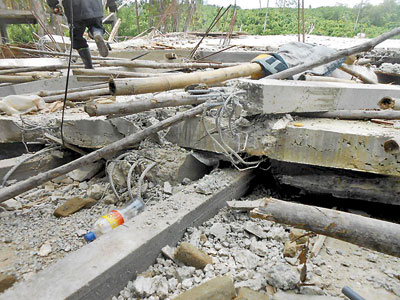
Rubble of the collapsed building
The Habaraduwa Pradeshiya Sabha at Ahangama, said approval was given in May 2015 for a three-storey building but the permission had lapsed. The developer had not sought a renewal.
Secretary, Mrs S D D C Dissanayake, said the developer has deviated from his plan and had added two more storeys. In addition, he had decided to construct a helipad. The concrete for the helipad had been poured on Friday, and on Monday, the supports had been removed. Then it collapsed. “At least 21 days are needed for the concrete to cure,’’ she claimed.
But the local authority has not checked the construction either.
Mrs Dissanayake, said that it is difficult to monitor several projects in the 59 grama sevaka divisions in Ahangama. The local authority visits the building site only after completion and a certification of completion is requested by the builder. However, most builders do not ask for a certificate as it is only necessary if the property is to be sold, or a bank loan is to be sought.
She said builders can be fined for unauthorised work. “Charges are by the square meter.’’
The National Construction Association of Sri Lanka, southern branch, which had inspected the building in Ahangama, said it had been constructed without the assistance of a proper engineer. “They have had contractors and followed architectural drawings only. No engineers were involved,’’ president K. Liyanarachchi, said.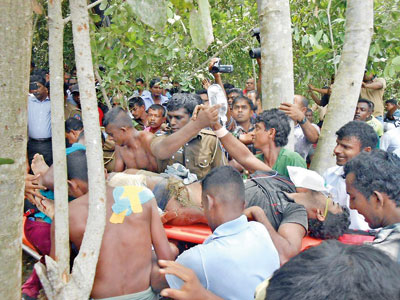
Local authorities approve completed buildings by checking ventilation, toilets, and bathrooms (waste water/septic tank) and by gauging the distance from the boundary wall.
And they ignore the beams, columns, the structural drawings, and soil testing which are more important.
Additionally, with the ban on excavation of river banks for sand, developers now use sand from land piling that does not blend with the cement.
Construction Industry Development Authority, charged that local authorities do not do any monitoring. “There is no monitoring system in place and this is the main cause. We cannot monitor. Only the authorities (the Urban Development Authority, the local authority can monitor,’’ the director of development, Savindra Amaraskera said.
He said the CIDA is planning to introduce legislation on building construction. “We have submitted the draft to the legal draftsman.’’
| In this school, parents fear for the lives of their children | |
| It is a life and death affair for nearly 400 students at the Eluwankulama Muslim Vidyalaya in Vanathavilluwa, because the school’s buildings could collapse any time, according to parents. They say they had made complaints to several authorities but little or no action had been taken to reinforce the buildings or demolish them and build new ones. They urge the authorities to act fast before a tragedy strikes. The school was built when the Eluwankulama village was set up under the 1958 resettlement programme following the recommendation of former Speaker H. S. Ismail, the area MP. The condition of the two out of the four buildings was precarious. The school authorities are conducting classes for GCE Ordinary and Advanced level students in temporary huts with thatched roofs in the school yard. Parents say students were facing untold hardship because even these huts were in a bad condition. There was little protection from the sunlight and rain because the thatched roof had decayed and had gaping holes in may places. 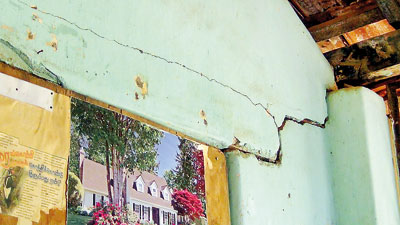 A ticking time bomb: The school building could collapse any time 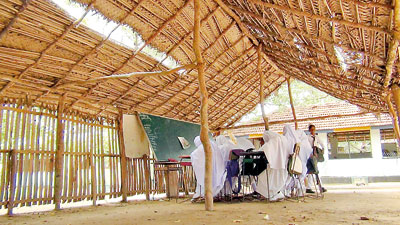 The state of the temporary huts. Pix by Hiran Priyankara Jayasinghe |

